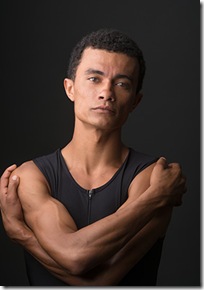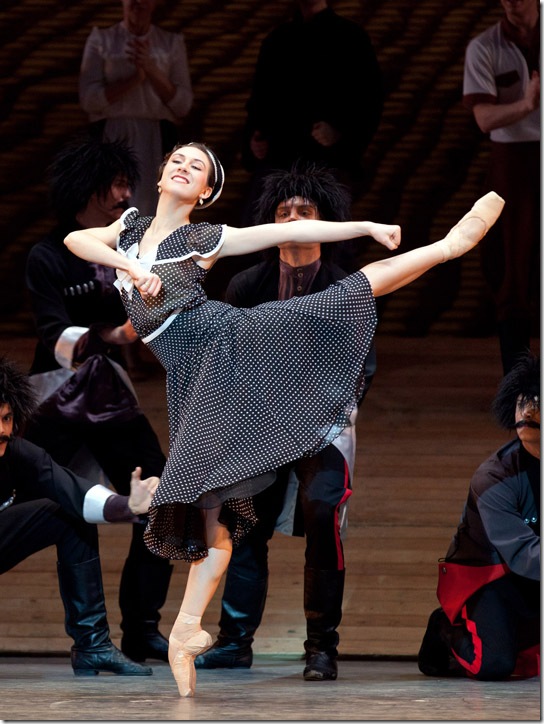Reared in the orphanages of rural southwest Brazil, Gleidson Vasconcelos found his future one day as he looked into a window he was passing, and saw a girl dancing to the sound of a music box.
“’She must be having a really great time doing what she is doing. She is so beautiful and free,’” Vasconcelos remembers thinking.
Seen at the window by a dance teacher, the 10-year-old boy was recruited to dance with the girl. Blessed with limber and elegant lines and a quick brain, he was soon performing as a dancer. He vividly remembers the freeing sensation of dancing in front of an audience for the first time.
“Every time that I am onstage and I ask, why do I do what I do, I go back to the first time I ever danced and remember how I felt,” said Vasconcelos, now a member of Ballet Arizona.
Beginning tonight, the Harid Conservatory, which gave Vasconcelos a full scholarship in 2003, celebrates the 25th anniversary of its founding with three performances at the Countess de Hoernle Theater on the campus of Spanish River High School in Boca Raton.
“Telling people that I came from Harid is like telling people that I come from a good family,” said Vasconcelos.
The concerts will include the premiere of Beautiful Dreamer, by resident choreographer Mark Godden, the Adagio and Pas de Trois from Marius Petipa’s Paquita, the Waltz from Act I and the Hungarian Czardas from Act III of Tchaikovsky’s Swan Lake, as well as August Bounrnonville’s Flower Festival in Genzano.
The performances will feature alumni guest artists from the Joffrey Ballet tonight and the Royal Winnipeg Ballet on Saturday and Sunday.
The Harid Conservatory was founded by businessman Fred Lieberman, who modeled it after the free-tuition Curtis Institute in his native Philadelphia. Students would be accepted based on their talent; the dance school was followed five years later by a music program. In time, the music division became too costly to support and in 1999 was taken over by Lynn University, which turned it into its music conservatory.
Lieberman, who always maintained that dance was his first artistic love, never let his support for the school waver but he wanted his status as benefactor to be anonymous, and it was only after his death in 2008 that the faculty and students found out who he was.
 Vasconcelos found his way to Harid after a short visit to a studio in Rio de Janeiro, where he met, for the first time, serious young dancers who said they were going to dance at American Ballet Theatre or the Royal Ballet. One of them was Isadora Loyola, who told Vasconcelos she was on her way to the United States for summer training at Harid and encouraged him to go, too.
Vasconcelos found his way to Harid after a short visit to a studio in Rio de Janeiro, where he met, for the first time, serious young dancers who said they were going to dance at American Ballet Theatre or the Royal Ballet. One of them was Isadora Loyola, who told Vasconcelos she was on her way to the United States for summer training at Harid and encouraged him to go, too.
It turned out to be almost that easy: In Loyola’s luggage when she returned to Boca Raton for a full year of study was a video of Vasconcelos dancing, along with a letter of recommendation from his teacher, Ludmilla Polanskaya, to Svetlana Osiyeva, her former classmate from Russia who was on the Harid faculty.
Not long afterward, Vasconcelos found himself walking into the Harid studios.
“The first thing I noticed was that it was so clean, and that there was so little noise,” he said. “It was an atmosphere that made you want to work really hard.”
Victoria Schneider, who has taught at Harid for 17 years, had her own dream of dancing defined when she was 10 and her mother gave her Days With Ulanova, a book about the legendary Russian ballet dancer Galina Ulanova. Filled with black-and-white photographs of young dancers in the ballet studios of the Bolshoi Academy, the book mesmerized Schneider, so much so that she told her mother she wanted to go to Russia to study ballet. Because Russia at that time was the Soviet Union, her mother declined to send her.
Schneider ended up training elsewhere, but said she always knew she ultimately wanted to teach dance. “I was always interested in the hows and whys,” she said.
She taught for nine years at the Pennsylvania Ballet School, where she developed a close relationship with artistic director Benjamin Harkarvy and the eminent ballet teacher Lupe Serrano, who teaches at Julliard and American Ballet Theatre. Both firmly believed that to be a good teacher you had to dedicate yourself to the serious study of technique.
Schneider taught dance for three years in Italy afterward, and then was invited to become the founding director of the Tampa/Colorado Ballet. While in Tampa, she took courses in the Vaganova method, the dominant dance discipline in Russia, from Jurgen Schneider, the ABT’s ballet master. After the Tampa/Colorado Ballet was dissolved in 1990, she traveled extensively with Jurgen Schneider, continuing to learn about the Vagonava technique and eventually teaching “the little ones.”
Jurgen, who became Schneider’s husband, arranged for her to observe courses at the Vaganova School in 1993 during a trip to Russia. She was invited to join the program a couple months later, and today is one of only two Americans to be officially certified to teach the technique by the Vaganova School itself.
After returning to the United States, she was quickly recruited by Harid.
“Young dancers don’t realize that it is about the ballet, not about them,” she said. “We are visitors in ballet. We just have the responsibility to keep ballet at the highest level. Ballet will continue.”
He added that the Vaganova method helps them get there.
“The dancers who arrive at Harid as 13-to-14-year-olds have often studied eight to 12 years of ballet. Expressivity isn’t build into their foundation, especially with the use of the port de bras and the back,” Schneider said. “The Vaganova training is very involved and there is a going-back process that needs to happen, a complete reworking that starts from how you put your feet on the floor.”
Harid’s alumni, several of whom will be on hand for the celebratory programs, include successful dancers such as Loyola, who along with six other Harid graduates, are dancing at ABT. Last week, during ABT’s season at Lincoln Center, Harid graduates Marcelo Gomes and Isabella Boylston danced principal roles in John Cranko’s Onegin.
Vasconcelos looks back on his time at Harid with gratitude but also regret about his study habits.
“I now know that I could have worked harder. I could have been more grateful and I could have accomplished so much more,” he said. “Ballet was difficult … (but) Harid knew what they wanted to do for me. I didn’t have to struggle for anything. Until then, I was in survival mode. It felt like I was adopted by everyone; by the teachers, the staff, the kids, even the security guard.”
It was a long way from that window where he saw the girl dancing, and it turned out to be central to realizing his dream of success in the U.S.
“The whole experience at Harid was everything that I had wished for my whole life,” he said.
Tara Mitton Catao is a former choreographer and instructor of contemporary dance at the Harid Conservatory.
The Harid Conservatory’s 25th anniversary performances are set for 7:30 p.m. today and 3 p.m. Saturday and Sunday. Tickets are $22-$28. The program consists of classical and contemporary ballets that will showcase the 2013 graduating class as well as various guest artists who are Harid alumni. The performances will be at the Countess de Hoernle Theater, 5100 Jog Road, Boca Raton. Call 561-998-8038 or visit www.harid.edu.
